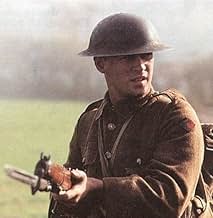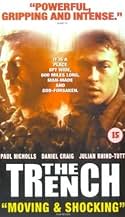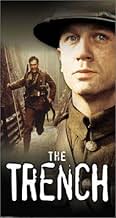En juillet 1916, deux jours avant la bataille de la Somme, une section de l'armée britannique se prépare au combat. Une trentaine de jeunes gens vont devoir vivre ces 48 heures dans l'angois... Tout lireEn juillet 1916, deux jours avant la bataille de la Somme, une section de l'armée britannique se prépare au combat. Une trentaine de jeunes gens vont devoir vivre ces 48 heures dans l'angoisse et la terreur d'une mort plus que certaine.En juillet 1916, deux jours avant la bataille de la Somme, une section de l'armée britannique se prépare au combat. Une trentaine de jeunes gens vont devoir vivre ces 48 heures dans l'angoisse et la terreur d'une mort plus que certaine.
- Réalisation
- Scénario
- Casting principal
- Récompenses
- 2 victoires et 2 nominations au total
- Pte. Horace Beckwith
- (as Anthony Strachan)
Avis à la une
"The trench" succeeds in recreating a gloomy nightmarish blue-green atmosphere ,but is short on screenplay.The story is never really interesting and there is worse: the director is incapable of creating characters we could care for,which is a shame,when it deals with martyrs of WW1 .
The whole effect of "The Trench" is that of a filmed stage play. It could easily be transferred to the stage without losing much and maybe even gaining something. That is to say, the movie is not opened up much. Still, as a WW I buff, I enjoyed it.
The actors are good, and the outline of the story is illustrative of typical situations in the war. However, the specific dialogue might be a little too 1999 rather than 1916. The film does remind us that wars are fought by men who are still boys and concerned about the things young men are obsessed by.
One general situation that jumps out is the promise to the men that they would go into the enemy trenches after bombardment and after previous waves of a British attack and would not encounter any living enemy. (Mopping up, as my WW-II-veteran father called it.) But this was a typical false promise of the strategy used by both sides because the defenders would always cover themselves adequately so a majority would survive the bombardment, and they would almost always be able to get reinforcements into the trenches faster than attackers could make it across NML, and the preliminary bombardment would 1) warn the defenders an attack was coming and 2) chew up the ground making it harder for the attackers to cross, including merely rearranging the barbed wire instead of cutting through it. The result was that being the defender was always advantageous, and being the attacker was always disadvantageous in trench warfare. That's why most of the battle lines on the Western Front remained static for about four years.
I would recommend this movie as worth seeing for world war buffs and Daniel Craig fans, although it likely won't be anyone's favorite movie.
Two things seem obvious as cultural distortions in this film. The first is the casual, almost disrespectful attitude and unruliness of the soldiers. This isn't something that happens just once or twice, but frequently. While all military throughout history likely has had some humor and playful banter among troops at times, it seems to be more of the rule among this platoon of Brits. The second is in the language. Again, all military throughout history likely has had some use of foul or rough language. But here, it seems that this 1916 platoon of British soldiers has adopted early 21st century British street talk (is it really that vulgar among society in England today?). And, I doubt that the British may always have had more vulgar mouths than we Yanks. But, by the standard of this film, the Brits make the service times of my family, from WW II through Vietnam, seem like baby talk.
There may be any number of other distortions as well. Anthony Strachan, who plays Horace Beckwith, is very good in his role. But I doubt that a man so much over weight would have been conscripted or allowed to join the British Army then, or any time. I knew some men a little over weight at my boot camp, but they were whipped into shape by the end, usually with much less weight to carry around. The men in this film seemed almost constantly to be smoking cigarettes. Cigarette smoking grew immensely during WW I, but it wasn't yet to the point shown in this film among British soldiers. In a long documentary film of WWI that came with the DVD of this movie, I didn't see a single scene of men smoking cigarettes on the French, British and German lines. But, several scenes showed Allied soldiers in the trenches smoking pipes.
The last couple of gross inaccuracies are in the setting. The movie folks did a credible job building the set of trenches – except for one thing. Where is the water and mud? The Allied trenches of WWI were notorious for their foul water and mud, yet we don't see any of that here. And, the scene of the battlefield that the Brits have to charge onto is a lush green meadow. That was almost laughable. Both sides had been bombarding that area for days on end. The land was a desolate wasteland.
The distorted portrayal of the conditions and culture are significant enough to cost this film two stars, so I can rate it no higher than six stars. I base that mostly on the fine performances of the cast – all the actors. The setting of this film was in the days leading up to the first day of the British attack in the Battle of the Somme (July 1 to November 18, 1916). That first day – when this film ends – cost more than 60,000 British soldiers wounded or killed. It's considered the bloodiest slaughter in the history of the British Army.
I mentioned a bonus documentary that came on the DVD with this film. "World War I: On the Western Front" is an excellent lengthy documentary of WWI. It is a CBS News documentary that shows only actual battle film of the French, British and German forces. It is narrated by actor Robert Ryan. That documentary is centered around the Battle of Verdun which cost more than 500,000 lives. It shows scenes all along the Western Front. Men are standing in deep water in the trenches. Men and machines try to move over drenched and muddy roads and fields. And, battlefields between the lines are a no-man's wasteland. Not a blade of grass, flower or tree can be seen. None of that was staged by Hollywood, but Hollywood (in the U.S. and abroad) would do well to study such actual war films to better and more accurately portray scenes in war movies.
Le saviez-vous
- AnecdotesIn preparation for the film, Writer and Director William Boyd sent the main cast to a replica trench for a night, to experience the conditions the British Army suffered.
- GaffesThe shelling of German trenches and the nomansland before the actual attack was immense. First of all the shelling would have been deafening, secondly, the nomansland would have been a moon-like scenery full of craters and barbwire, not a nice meadow.
- Citations
Pte. Charlie Ambrose: [in a mocking whine] You can tell your grandchildren, I was wounded by a flyin' tooth.
[everyone laughs]
- ConnexionsFeatured in Being James Bond (2021)
Meilleurs choix
- How long is The Trench?Alimenté par Alexa
Détails
- Date de sortie
- Pays d’origine
- Langues
- Aussi connu sous le nom de
- La trinchera
- Lieux de tournage
- Sociétés de production
- Voir plus de crédits d'entreprise sur IMDbPro
- Durée1 heure 38 minutes
- Couleur
- Mixage
- Rapport de forme
- 1.85 : 1

































